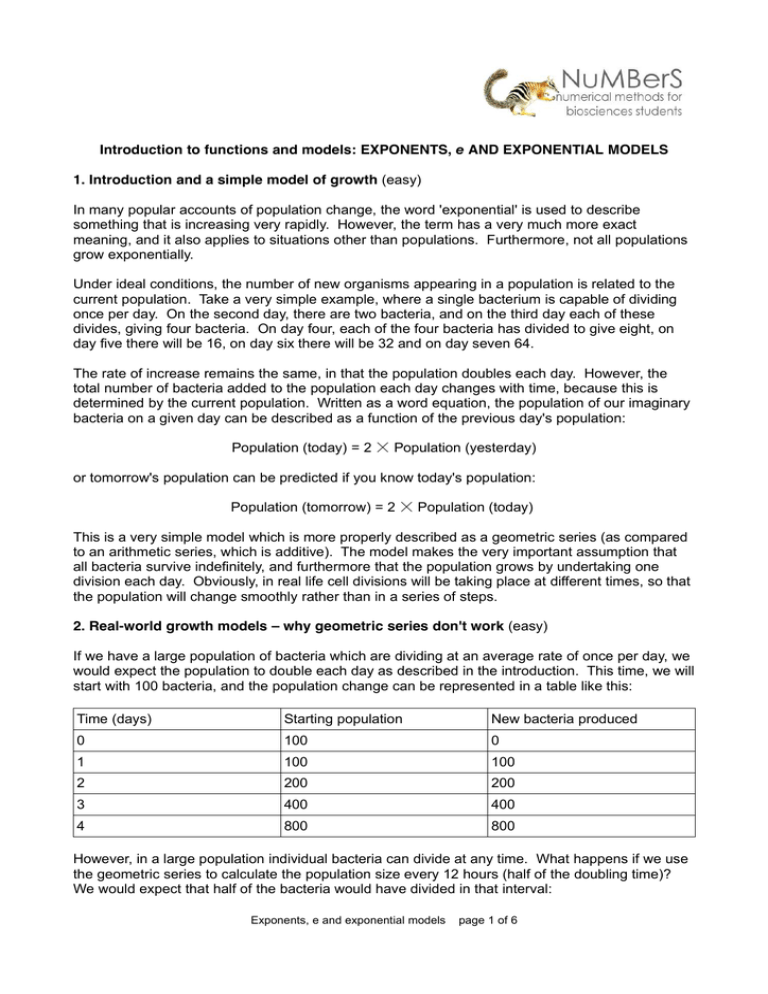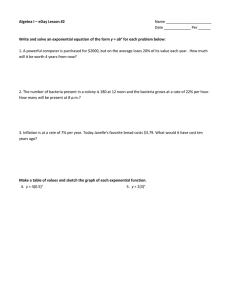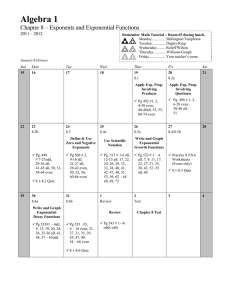Exponential Growth and e
advertisement

Introduction to functions and models: EXPONENTS, e AND EXPONENTIAL MODELS
1. Introduction and a simple model of growth (easy)
In many popular accounts of population change, the word 'exponential' is used to describe
something that is increasing very rapidly. However, the term has a very much more exact
meaning, and it also applies to situations other than populations. Furthermore, not all populations
grow exponentially.
Under ideal conditions, the number of new organisms appearing in a population is related to the
current population. Take a very simple example, where a single bacterium is capable of dividing
once per day. On the second day, there are two bacteria, and on the third day each of these
divides, giving four bacteria. On day four, each of the four bacteria has divided to give eight, on
day five there will be 16, on day six there will be 32 and on day seven 64.
The rate of increase remains the same, in that the population doubles each day. However, the
total number of bacteria added to the population each day changes with time, because this is
determined by the current population. Written as a word equation, the population of our imaginary
bacteria on a given day can be described as a function of the previous day's population:
Population (today) = 2 ܈Population (yesterday)
or tomorrow's population can be predicted if you know today's population:
Population (tomorrow) = 2 ܈Population (today)
This is a very simple model which is more properly described as a geometric series (as compared
to an arithmetic series, which is additive). The model makes the very important assumption that
all bacteria survive indefinitely, and furthermore that the population grows by undertaking one
division each day. Obviously, in real life cell divisions will be taking place at different times, so that
the population will change smoothly rather than in a series of steps.
2. Real-world growth models – why geometric series don't work (easy)
If we have a large population of bacteria which are dividing at an average rate of once per day, we
would expect the population to double each day as described in the introduction. This time, we will
start with 100 bacteria, and the population change can be represented in a table like this:
Time (days)
Starting population
New bacteria produced
0
100
0
1
100
100
2
200
200
3
400
400
4
800
800
However, in a large population individual bacteria can divide at any time. What happens if we use
the geometric series to calculate the population size every 12 hours (half of the doubling time)?
We would expect that half of the bacteria would have divided in that interval:
Exponents, e and exponential models
page 1 of 6
Time (days)
Starting population
New bacteria produced
0
100
0
0.5
100
50
1
150
75
1.5
225
113
2
338
169
2.5
508
254
3
762
381
3.5
1143
572
4
1715
857
In this second calculation, the growth rate is still the same (once per day) but we have evaluated
the series at 12 h (0.5 day) intervals and the population appears to grow faster. This is because
the bacteria added at each interval contribute to the 'current' population that will divide in the next
interval.
So which model is correct? The answer, sadly, is neither! The bacteria are the same, each one
dividing once per day. But the population calculations are dependent on the time interval used. If
we calculate the geometric series using different time intervals, we see that we approach a stable
value for population growth as the interval gets smaller and smaller. This can be seen if we use
the population after one day as a benchmark:
Time interval for
calculation (days)
Number of bacteria after
one day
1
200
0.5
225
0.25
254
0.1
260
0.05
266
0.02
269
0.01
271
0.005
271
Decreasing the time interval in a geometric series like this does two things – it adds new bacteria
to the population more quickly (increasing the current population) but also decreases the
population increase at each time-step (because the time interval decreases). So we expect that
as we shorten the time interval more and more, the population growth curve will gradually settle
down to the same value.
It is easy to evaluate the geometric series in a spreadsheet, but it becomes tedious to calculate
populations over long periods of time with very short time intervals. More importantly, the growth
rate over very short intervals is not a simple fraction of the average growth rate. Instead of the
simple geometric series, we need a population growth model that can be evaluated for any time
and is independent of time interval.
Exponents, e and exponential models
page 2 of 6
3. An exponential model for population growth (intermediate)
We introduced the geometric series in a 'word equation' like
Population (tomorrow) = Daily rate of increase ܈Population (today)
We have then shown that we can decrease the time interval over which we evaluate the series,
and gradually approached a population growth curve that does not change significantly for further
decrease in interval. We can write a new word equation for this curve, which involves an
exponent:
Population (tomorrow) = Population (today) ܈exponent (growth constant ܈time difference)
This gives us a way to measure the population change reliably at any time, or for any time
difference. Written in a mathematical format:
Pt = P0. exp(k.t)
The values in this equation are:
P0 is the initial population, and Pt is the population at time t
The expression exp(k.t) is termed the 'exponent' of the time (t) multiplied by a growth
constant (k), which has the units of time-1 (that is, 'per unit time').
This can be set up using a spreadsheet, and a plot of an exponential growth model looks like this:
Bacterial population versus time
1100000
1000000
Population (number of cells)
900000
800000
700000
600000
500000
400000
300000
200000
100000
0
0
2.5
5
7.5
10
12.5
15
17.5
20
Time (days)
4. Exponential functions from the ground up (advanced – you can skip to section 5 if you wish)
Mathematically we start with the growth of the population (P) over time (t) such that:
dP/dt = kP
Over a time interval, denoted by δt ('delta-t'), the mathematical solution to this equation is:
P(t+δt) = Pt. exp(k.δt)
where Pt and P(t+δt) are the population sizes at times t and (t + δt) respectively.
Exponents, e and exponential models
page 3 of 6
This is an exponential function, hence the name exponential growth. The expression:
exp(k.δt) is another way of writing e(k.δt)
[Technical note: e is called Euler's number or Napier's constant and is one of the most important
numbers in mathematics. The other important numbers are 1, 0, the imaginary value i and π. e is
a constant, with a value of 2.71828 18284 59045 23536... In mathematical terms e is the unique
real number so that the derivative of the function f(x) = ex at the point where x = 0 is equal to 1.
The function ex is called the exponential function and the inverse of this number is the natural or
Naperian logarithm. Find out more at:
http://en.wikipedia.org/wiki/E_%28mathematical_constant%29
http://betterexplained.com/articles/an-intuitive-guide-to-exponential-functions-e/ ]
5. Doubling time for populations (intermediate)
We started this document by looking at a geometric series as a simple model for population
growth. However, we showed that this is not a robust model, as it does not allow us to make valid
calculations for intermediate time-steps. From there, we moved to an exponential model of the
form:
Pt = P0. exp(k.t)
Where:
P0 is the initial population, and Pt is the population at time t
The expression exp(k.t) is termed the 'exponent' of the time (t) multiplied by a growth
constant (k), which has the units of time-1 (that is, 'per unit time').
A more general version of this equation is:
Pt2 = Pt1. exp(k.[t2-t1])
where Pt1 and Pt2 are the population sizes at times t1 and t2 respectively, and [t2-t1] is the time
interval separating these two observations.
For the initial example with the geometric series, we looked at a population whose population
doubled each day. In this case, the period of one day is termed the doubling time. So how is the
value of the growth constant, k, related to doubling time?
If we look at the population size at two times that are separated by the doubling time, tD, we can
rewrite the last equation:
t2-t1 = tD
Pt2 = Pt1. exp(k.tD)
We also know that the population will have doubled over this period (by definition), so that:
Pt2 = 2.Pt1
So the growth equation can be rewritten in terms of Pt1 only, and then re-arranged to give a
relationship between k and tD:
Exponents, e and exponential models
page 4 of 6
2.Pt1 = Pt1. exp(k.tD)
exp(k.tD) = 2.Pt1/Pt1 = 2
k.tD = ln(2)
The symbol 'ln' indicates the natural logarithm (that is the logarithm expressed to the base e). So
it is now possible to calculate the value of k for a given doubling time, or the doubling time if you
know k:
k = ln(2)/ tD
tD = ln(2)/k
In the case of a doubling time of one day, the value of k is 0.693147 d-1, whilst for doubling times
of two and five days the values are 0.346573 d-1 and 0.138629 d-1 respectively. Note that the
constant is written with units 'per day' – it would have a different value if we had used hours as
units but kept the doubling time as one day (ie 24 h).
6. Negative exponents (intermediate)
If you plot an exponential growth curve, it is clear that the slope (gradient) of the curve increases
as the independent variable (for instance time) increases. The rate at which the slope changes is
determined by the constant, denoted k in previous sections.
If k is negative, the dependent variable decreases as the independent variable increases. Instead
of increasing, the slope of a negative exponential curve decreases as the independent variable
increases, so that the curve appears gradually to level out. An example is shown here:
Example negative exponential function
100
90
80
70
60
50
40
30
20
10
0
0
2.5
5
7.5
10
12.5
15
17.5
20
22.5
25
An example of exponential decrease (or decay) is the absorption of light by a medium such as
water. Imagine that each photon has a defined chance of being absorbed as it traverses a metre
of water. If this chance is 5% (1 in 20), 95% of the photons will pass through a metre of water.
Over the next metre, 5% of the remaining photons will be absorbed, leaving 90.3% of the photons
to enter the third metre layer. As the number of photons decreases, the number absorbed over
each successive metre also decreases.
Exponents, e and exponential models
page 5 of 6
We can write a relationship between light level and depth as an exponential function:
Ez = E0.exp(-KD.z)
where E0 and Ez are the light intensity at the surface and a depth of z metres, respectively, and KD
is the absorption coefficient (more properly the 'diffuse attenuation coefficient', in units of depth-1).
An important quantity in the functioning of aquatic ecosystems is the depth to which sufficient light
penetrates to allow photosynthetic growth to take place. Although many different factors influence
the minimum amount of light plants need for photosynthesis, a good rule of thumb at least for the
open ocean is that photosynthetic growth is possible down to 1% of the light incident at the
surface. If we term this depth z1% and call the 1% light level E1%, we can rewrite the equation:
E1% = E0.exp(-KD.z1%)
We can rewrite E1% in terms of E0, and then put this value into the equation and re-arrange this to
give an equation relating depth and KD:
E1% = 0.01 . E0
0.01 . E0 = E0.exp(-KD.z1%)
exp(-KD.z1%) = 0.01 . E0/E0 = 0.01
-KD.z1% = ln(0.01)
The symbol 'ln' indicates the natural logarithm (that is the logarithm expressed to the base e). So
it is now possible to calculate the value of KD for a known 1% 'light depth', or the 1% depth if you
know KD:
KD = -ln(0.01)/z1%
z1%= -ln(0.01)/KD
[Technical note: the logarithm of a number less than one has a negative sign. KD is conventionally
written as a positive number, so the minus sign in the exponent provides an answer in 'positive'
metres.]
For a 1% light depth of 50 m, the value of KD is 0.092103 m-1, whereas for a 1% light depth of 20
m KD is 0.230258 m-1 (note the units of 'per metre'). The diffuse attenuation coefficient increases
as water becomes more turbid (ie absorbs more light), corresponding to a shallower 1% light
depth. In the initial discussion of light penetration, we suggested that photons had a 5% chance of
being absorbed within one metre. Thus KD is 0.05, and the 1% light level occurs at a depth of 92
m – the sort of value that is only found in very clear water such as the middle of deep ocean areas.
You can use the same basic equation to work out the proportion of surface light that reaches a
given depth, z* if you know the value of KD:
Ez* = E0.exp(-KD.z*)
Ez*/ E0 = exp(-KD.z*)
Where the expression Ez*/E0 is the proportion of surface light at a depth of z*. If you wanted to
express this as a percentage, you would need to multiply the result by 100.
Exponents, e and exponential models
page 6 of 6



